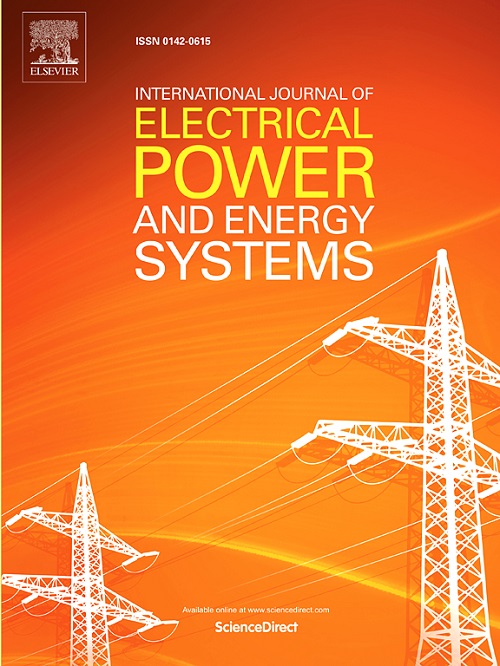Low voltage ride-through capability enhancement using optimal super twisting sliding mode control for grid-tied pv systems
IF 5
2区 工程技术
Q1 ENGINEERING, ELECTRICAL & ELECTRONIC
International Journal of Electrical Power & Energy Systems
Pub Date : 2025-09-16
DOI:10.1016/j.ijepes.2025.111124
引用次数: 0
Abstract
This paper addresses the critical issue of enhancing the low-voltage ride-through (LVRT) capability of grid-tied photovoltaic power (GTPVP) systems, particularly in compliance with modern grid codes (GCs) during grid faults. It proposes a novel control strategy using super-twisting sliding mode control (STSMC) for a 100-MW PV system, with the gains of the STSMC optimized through a Newton-Raphson-based optimizer (NRBO). The NRBO is also employed as a maximum power point tracker to regulate PV voltage based on a STSMC. Additionally, the STSMCs are integrated into the voltage source inverter for optimal control of various parameters, including the DC-link voltage, active, and reactive currents. Furthermore, the effectiveness of the NRBO-STSMC is validated through comparative analysis against other methods, such as particle swarm optimization (PSO)-tuned STSMC, NRBO-based conventional SMC, and NRBO-tuned proportional-integral (PI) controllers. A MATLAB/Simulink model was utilized for optimization and simulation, demonstrating that the NRBO-STSMC achieved superior performance, with the lowest integral of time-weighted absolute error values and higher efficiency, for both DC-DC and DC-AC converters. It minimizes voltage overshoot at the point of common coupling and ensures stable power injection during severe grid faults. In contrast, the NRBO-SMC method shows significant overshoots, while the NRBO-PI method faces oscillations and poor power balance. The study concludes that the proposed NRBO-STSMC successfully complies with the IEEE 1547 LVRT grid code during the grid fault. It provides a robust, highly efficient, and stable control solution for the LVRT issue of GTPVP systems, proving essential for meeting the demands of modern GCs.
利用最优超扭滑模控制提高并网光伏系统的低压穿越能力
本文讨论了提高并网光伏发电(GTPVP)系统的低压穿越(LVRT)能力的关键问题,特别是在电网故障时符合现代电网规范(GCs)。针对100兆瓦光伏系统,提出了一种利用超扭转滑模控制(STSMC)的控制策略,并通过基于牛顿- raphson的优化器(NRBO)对STSMC的增益进行优化。NRBO也被用作最大功率点跟踪器来调节基于STSMC的PV电压。此外,stsmc集成到电压源逆变器中,以实现各种参数的最佳控制,包括直流链路电压,有功和无功电流。此外,通过与其他方法(如粒子群优化(PSO)调谐STSMC、基于nrbo的传统SMC和nrbo调谐比例积分(PI)控制器)的对比分析,验证了NRBO-STSMC的有效性。利用MATLAB/Simulink模型进行优化和仿真,结果表明NRBO-STSMC在DC-DC和DC-AC变换器中均具有较好的性能,具有时间加权绝对误差值积分最小、效率较高的特点。它最大限度地减少了共耦合点的电压超调,并确保在电网严重故障时稳定的电力注入。相比之下,NRBO-SMC方法表现出明显的过调,而NRBO-PI方法则面临振荡和较差的功率平衡。研究结果表明,NRBO-STSMC在电网故障期间成功地符合IEEE 1547 LVRT电网规范。它为GTPVP系统的LVRT问题提供了一个强大、高效和稳定的控制解决方案,证明了满足现代gc需求的必要性。
本文章由计算机程序翻译,如有差异,请以英文原文为准。
求助全文
约1分钟内获得全文
求助全文
来源期刊
CiteScore
12.10
自引率
17.30%
发文量
1022
审稿时长
51 days
期刊介绍:
The journal covers theoretical developments in electrical power and energy systems and their applications. The coverage embraces: generation and network planning; reliability; long and short term operation; expert systems; neural networks; object oriented systems; system control centres; database and information systems; stock and parameter estimation; system security and adequacy; network theory, modelling and computation; small and large system dynamics; dynamic model identification; on-line control including load and switching control; protection; distribution systems; energy economics; impact of non-conventional systems; and man-machine interfaces.
As well as original research papers, the journal publishes short contributions, book reviews and conference reports. All papers are peer-reviewed by at least two referees.

 求助内容:
求助内容: 应助结果提醒方式:
应助结果提醒方式:


